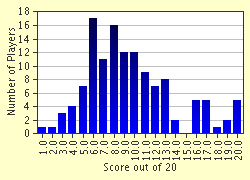Quiz Answer Key and Fun Facts
1. The only non-royal (or former non-royal) building in England to be termed a palace is Blenheim. Who resides there?
2. What is Holyrood House?
3. Who originally built Hampton Court?
4. Chenonceau, though small, is one of the jewels of the Loire valley. It is known as the "chateau of the ladies". Which of these ladies played no part in its history.
5. One of the favourite picture postcards of the Alpine area shows the fairy tale castle of Neuschwanstein perched atop its mountain. Which monarch was responsible for its building?
6. Schloss Charlottenburg was the residence of which family?
7. The city of Celle served as the place of imprisonment for two queens and also as the residence of a Huguenot woman who seduced Georg-Wilhelm, the last Duke to live in Celle. Which woman played no part in the history of Celle castle?
8. Which of the following did not frequent the lodge outside Coburg called the Rosenau.
9. One of the massive hunting chateaux of the Loire is Chambord. With its central keep and distinctive roof line marked with chimney lanterns, it is truly memorable, but who built it?
10. Martin Luther spent several months in the Veste Coburg, the castle perched above the city of Coburg.
11. Which central European palace has a name that means "beautiful spring"?
12. The chateau birthplace of Henry IV, the first of the Bourbon kings of France contains many artifacts of the life of the "Evergreen Gallant". One of the exhibits is a large tortoise shell which served as his cradle. The town was also the birthplace of Jean Bernadotte, the future king of Sweden and founder of the present Swedish dynasty. The name of the chateau and the town are the same. What is it?
13. This palace contains a stunning display of the regalia, ceremonial dress and thrones of the Russian monarchy. What is the name of this palace?
14. Which of the many palaces owned by the Romanovs was the usual residence of Nicholas II and his family?
15. Schloss Orth is a picturesque lake schloss that was once owned by the Archduke Johann Salvator of Tuscany. Perched on a small island, is joined to the mainland by a 100 meter wooden bridge. Where is this schloss located? After breaking with the family, he became a seaman and obtained his masters licence. Although rumours persisted of his survival, he was apparently lost with his ship the Saint Margaret and its crew off Cape Horn. Where was his castle?
16. Although now ruined, the castle which once held Richard the Lionheart prisoner when he was captured by the Duke of Austria, Leopold V, is worth the steep climb to its lofty heights. The name of the castle and the name of the town are the same. What was the name of this castle?
17. Henry, Duke of Guise and uncle of Mary Queen of Scots was murdered at this chateau in the Loire Valley in 1588. It is also famous for its double staircase. What is this chateau?
18. This castle, also on the Loire, was an English stronghold on the Angevin part of France. Henry II build Fort St George as part of its defensive works. Later in history, Charles VII received Joan of Arc and was persuaded by her to commence the reconquest of France from the English. What is its name?
19. The favourite residence of Josephine, first wife of the Emperor Napoleon was called Malmaison.
20. The Brighton Pavilion was built in a rococo manner by George IV.
Source: Author
tripeuro
This quiz was reviewed by FunTrivia editor
bloomsby before going online.
Any errors found in FunTrivia content are routinely corrected through our feedback system.


